Superior Performance Of Alumina Ceramic Substrates In The Automobile Industry
Alumina ceramic substrate offers excellent overall performance and is an important material in the automotive sector. It contributes to enhanced vehicle performance, reduced fuel consumption and decreased exhaust emissions. Ongoing scientific and technological developments allow new materials and techniques to be employed during the development and production phases of motor vehicles. This progress supports the demand for lighter, more cost-effective, intelligent, economical and reliable cars. The alumina ceramic substrate has well-defined properties. It helps to reduce vehicle weight, fuel consumption and exhaust emissions. It enhances engine thermal efficiency and prolongs the service life of wear components. It also improves the operational functions of vehicles.
Application in the Engine
Alumina ceramic substrate tolerates temperatures exceeding 1 000 °C. This property facilitates new automotive applications. For example, Aluminiumoxidkeramik is employed to decrease diesel engine fuel consumption by more than 30%. About 78% of the combustion energy in an Otto engine is lost through heat transfer. Diesel engines operate at a thermal efficiency of 33%, yet more than 60% of the heat energy is dissipated. Consequently, the combustion chamber is insulated with ceramic material that exhibits good insulation properties to reduce energy loss. An exhaust turbocharger and a waste turbine are integrated to recover exhaust energy. Experiments indicated that the thermal efficiency can be increased to 48%. In addition, the diesel engine starts promptly when using the alumina ceramic substrate.

Applications in Automotive Sensors
Automotive sensors must operate over long periods in harsh environments. They should be small, lightweight and reusable. They must also cover a wide performance range. Recent advances in manufacturing technology have enabled the full utilisation of alumina ceramic substrate. Its heat resistance, corrosion resistance, wear resistance and effective electromagnetic and optical properties contribute to its suitability. Sensors manufactured from alumina ceramic meet these requirements.
Application in Automotive Shock Absorbers
High-performance vehicles utilise intelligent shock absorbers that employ the positive piezoelectric effect, the inverse piezoelectric effect and the electrostrictive effect of alumina ceramic. High-sensitivity alumina ceramic components allow the shock absorber to detect road surface conditions. The system adjusts automatically. Consequently, vibrations caused by rough road surfaces are reduced to a minimum.
In summary, alumina ceramic substrate is a ceramic product under continuous development. However, several issues in material preparation, evaluation and utilisation technology remain to be resolved. Given the rapid advancement of science and technology, more alumina ceramic substrates and intelligent ceramic products will be applied in the automotive industry in the future.

 Bars
Bars
 Beads & Spheres
Beads & Spheres
 Bolts & Nuts
Bolts & Nuts
 Crucibles
Crucibles
 Discs
Discs
 Fibers & Fabrics
Fibers & Fabrics
 Films
Films
 Flake
Flake
 Foams
Foams
 Foil
Foil
 Granules
Granules
 Honeycombs
Honeycombs
 Ink
Ink
 Laminate
Laminate
 Lumps
Lumps
 Meshes
Meshes
 Metallised Film
Metallised Film
 Plate
Plate
 Powders
Powders
 Rod
Rod
 Sheets
Sheets
 Single Crystals
Single Crystals
 Sputtering Target
Sputtering Target
 Tubes
Tubes
 Washer
Washer
 Wires
Wires
 Converters & Calculators
Converters & Calculators
 Write for Us
Write for Us




 Chin Trento
Chin Trento



